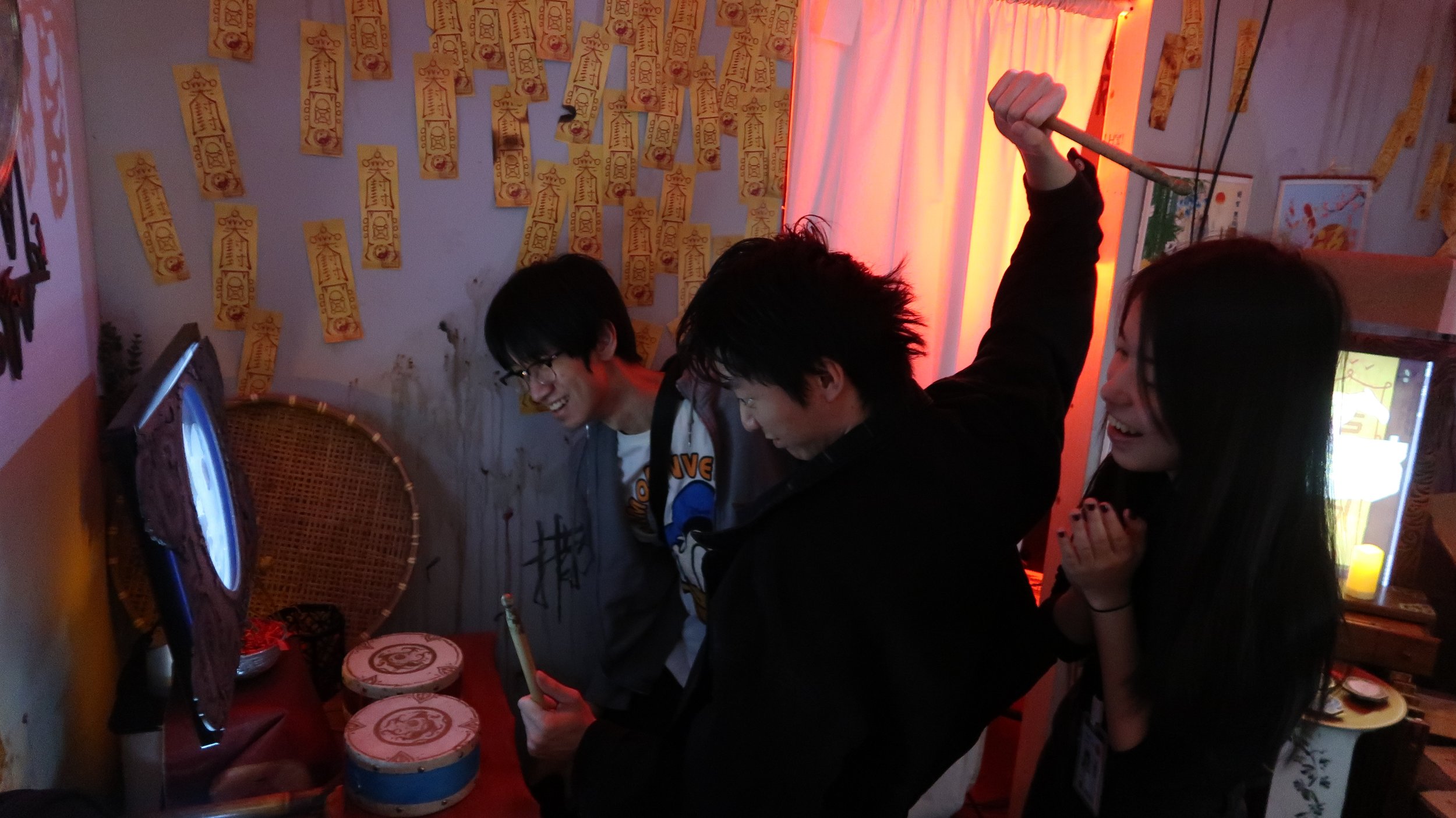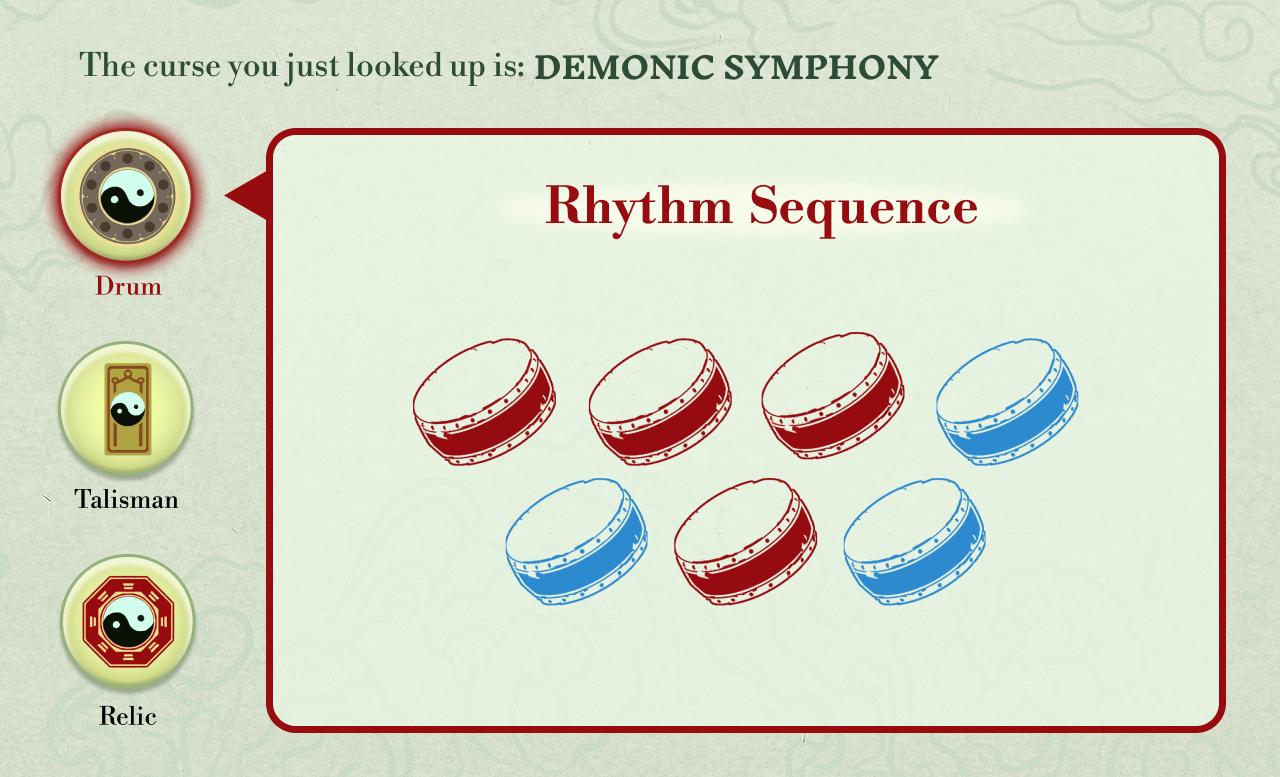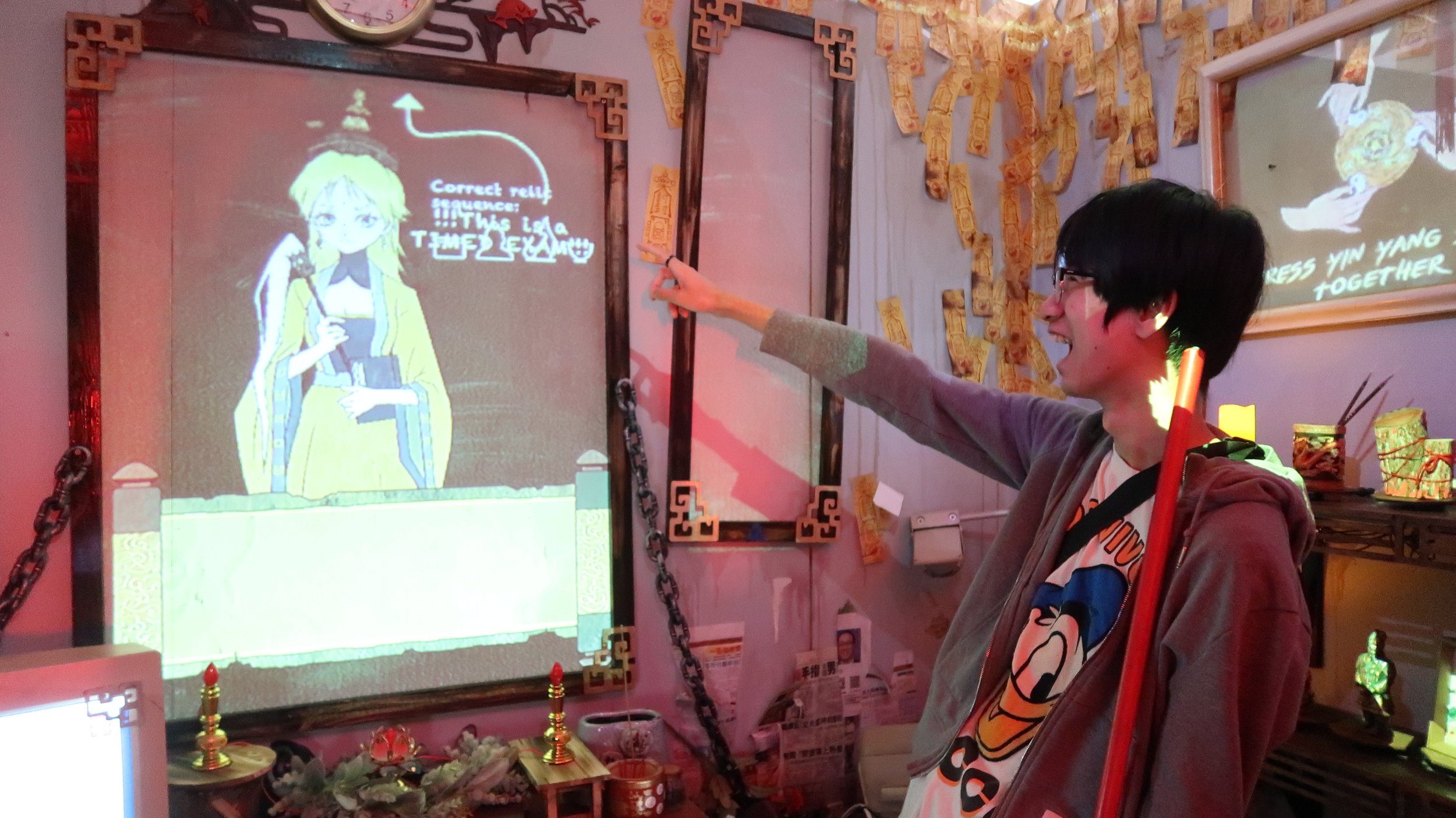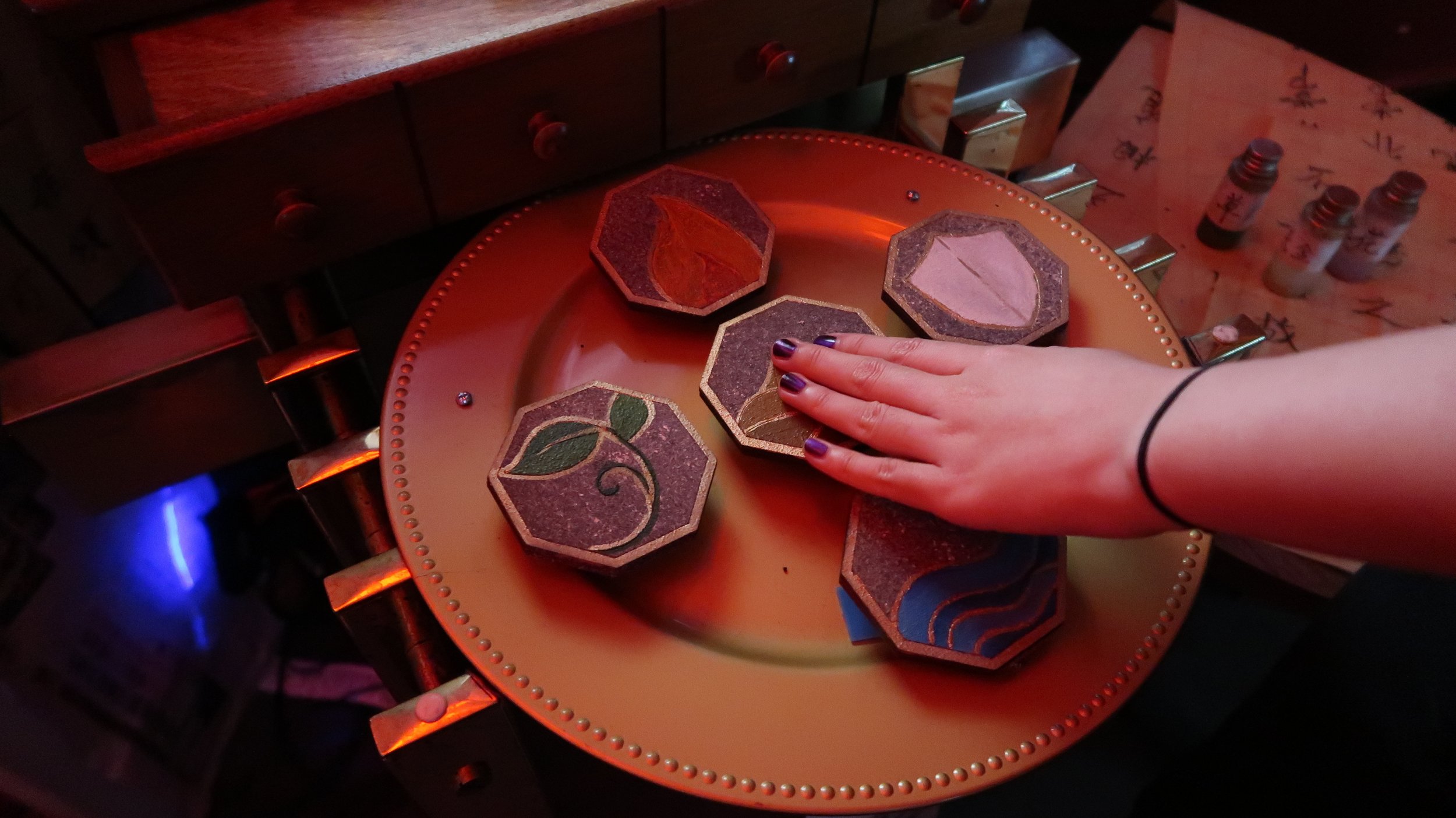Chú Mó 除魔
overview
Chú Mó is an immersive game where players step into the shoes of freshman exorcists at a haunted school. Combining escape room elements with traditional game development, you'll take an entrance exam, mastering the art of identifying and countering curses using relics, drums, and calligraphy.
As a team, you'll work together to combat eerie effects and seal away the demon. Dive into the world of East Asian exorcism in this unique school setting!
system design
technical design
ROLE
Lead Programmer
Game Designer
DURATION
02/2023 - 10/2023
TEAM
14
TOOL USED
Unity | Github | C# | Arduino | Makey
Welcome to Exorcism School! Today's exam puts you near a securely sealed demon. But remember, we're not responsible for your safety~ ✦
Welcome to Exorcism School! Today's exam puts you near a securely sealed demon. But remember, we're not responsible for your safety~ ✦
ACHIEVEMENT
✦ GDC 2024 Alt Control Award ✦
✦ IndieCade 2023 Live Action Award ✦
view details
view details
overview
As both the Game Designer and Lead Technical Designer for this project, my primary responsibilities entailed the conceptualization and precise definition of core gameplay mechanics. Leveraging my coding expertise, I translated these concepts into functional game systems, collaborating closely with my team to ensure the seamless integration of these mechanics.
My role also extended beyond code, as I utilized my game design acumen to refine and enhance the overall game experience, striving for a heightened level of immersion. As well as running playtests and creating actionable tasks to iterate the systems to create our intended player experience
Responsibilities
Created Gameplay Pillars
Designed Drum Station Mechanics
Designed all gameplay systems ranging from
Drum Station Mechanics
Scoring System
Content Systems Design
While designing a Taoist exorcism tool for our game, the most important job for me is to delve into historical Taoist rituals to gamify authentic elements. Discovering music's unique role in communicating with spirits in Taoism, and recognizing the unique satisfaction drum playing offers—beyond typical video game joys—I integrated drums and music into our game as player exorcism tools.
The gameplay at the drum station features three actions:
1
Drum Mechanics
Players deduce the correct red and blue drum patterns from the demon's curse. With increasing difficulty, patterns lengthen, challenging players to remember sequences under tighter time constraints.
3
Arduino sensors detect drum hits and colors by translating vibrations. Incorrect patterns signal errors and close the station, while correct ones trigger a 'complete' stamp, signaling successful completion.
There are three different levels of difficulty for the curses that players will face in the game, each worth different scores. Successfully overcoming as many curses as possible within the limited time earns the player a grade of A, B, or C. With this scoring system enables me to create a more detailed balance sheet, which significantly aids in evaluating and fine-tuning the game's difficulty levels.
2
Players press the Yin-Yang Button to infuse 'Chi' into the drum station, starting rhythm-specific beats. They hit differently colored drums in the correct pattern and timing.
Scoring System
Guided by the principle that clear goals and measurable progress motivate players, our game designs experiences around a player’s objective:
Together, they face an entrance exam—a series of curses escalating in difficulty, set against the clock.
This mirrors the student life familiar from everyone's childhood, providing a deep and engaging learning curve, and bridging the culture gap.
While designing this game, I also considered how to make a game rich in Chinese folklore elements accessible to a wider audience in a predominantly Western environment. My approach involved crafting a scoring system that transcends cultural boundaries, offering deep immersion to players from diverse backgrounds.
Leveraging my seasoned understanding of game dynamics and player psychology, I devised a scoring system that respects the narrative's essence while enhancing engagement and immersive gameplay.
TECHNICAL DESIGN
Makey-makey board
Drawing station ink shader effect
I wrote a shader capable of altering the texture of material through 'flow length,' 'flow magnitude,' and 'brush size'. By adding cursor detection to a mesh with a collider, it achieves an effect where players can paint, creating ink-style VFX.
Phidget
Game Feature
I developed a custom dialog controller, enhancing it to meet the specific requirements of our game.
Loudness Detection
I developed a voice detection system in Unity that captures audio from the computer's default microphone.
The core of the system captures audio input, saving it as an AudioClip. It then analyzes the waveform data of each audio frame to determine the loudness level. This loudness metric is used dynamically to adjust the scale of on-screen visual effects, providing real-time feedback based on the audio input's intensity.
To streamline testing across various devices for game designers, I've also implemented functionality that outputs the name of the active microphone to the console, ensuring ease of use and adaptability.
I utilized Makey Makey as an alternative controller by remapping it for three distinct stations, each linked to an arcade button. This setup allows Unity to interpret button presses as keyboard inputs, enabling a unique and interactive gaming experience where physical button actions directly influence in-game actions.
Shader
Dialog System
This controller is designed to deconstruct sentences into character arrays, synchronize text display with voice acting through precise timing, and activate other game objects for the tutorial. Each character appears sequentially, creating a dynamic conversation flow.
Key features include the incorporation of special functions within the text, identifiable by the "/function name/" syntax. These functions allow for on-the-fly modifications to the text's appearance, including color and size adjustments, and the introduction of pauses between lines for dramatic effect. This system intelligently recognizes and executes these embedded commands, enabling nuanced storytelling elements without manual intervention.
Alternative controller
Based on the Phydgit built-in feature in Unity, I integrated a custom dictionary, enabling control over connected devices like candles and fans. This setup allows for turning devices on or off programmatically to create immersive, real-world effects, such as flickering candles or activated fans, enhancing the gaming experience with physical interactions.
PUZZLE BALANCE
To balance the scoring system with the difficulty of the game. we aimed to ensure that first-time players typically earned a B grade on average, enhancing the game's replay value. This strategic adjustment encourages new players to invite friends for subsequent challenges, aiming for higher scores.
Meanwhile, seasoned players often achieve an A grade on their second attempt, striking a balance between accessibility for beginners and rewarding mastery for veterans.
Based on the overall game system, I have created three levels of difficulty for curses: easy, normal, and hard.
I control the game's difficulty through the following three variables:
The average time required for different puzzles
Given the game's time limit, the duration puzzles of varying difficulties take helps gauge their difficulty.
The average score of different players
This measures player performance across puzzles, offering insights into their accessibility and challenge for varying skill levels, such as first-time players versus those who have played twice or more.
The completion rate for puzzles of varying difficulties
This tracks the success rate of players for puzzles at each difficulty, clearly showing how players adapt to and overcome challenges.




















